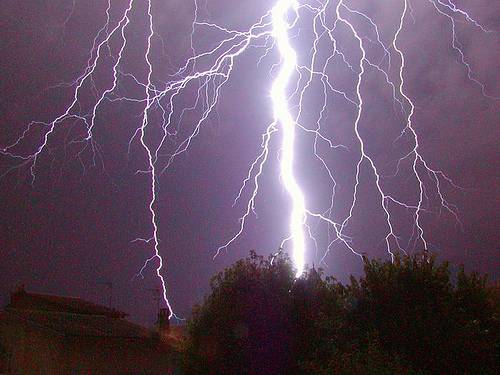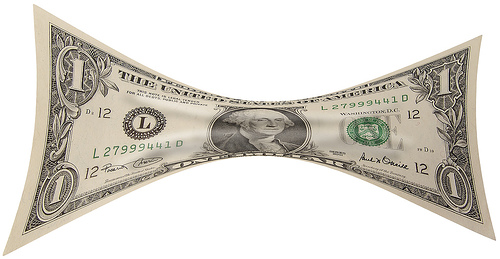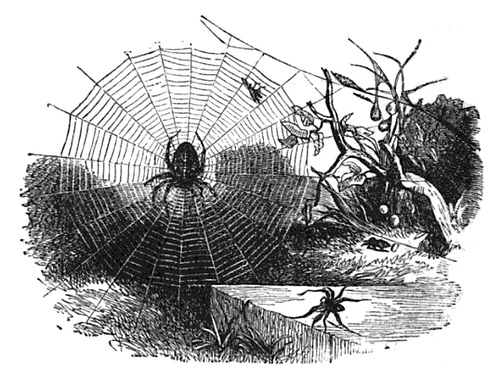abligurition
n. excessive spending on food and drink
Month: May 2007
Proof That 4 Equals 3
a + b = c
4a – 3a + 4b – 3b = 4c – 3c
4a + 4b – 4c = 3a + 3b – 3c
4(a + b – c) = 3(a + b – c)
4 = 3
“Lightning-Prints”

Lightning-prints are appearances sometimes found on the skin of men or animals that are struck by lightning, and are currently believed to be photographic representations of surrounding objects of scenery.
At Candelaria, in Cuba, in 1828, a young man was struck dead by lightning near a house, on one of the windows of which was nailed a horse-shoe; and the image of the horse-shoe was said to be distinctly printed upon the neck of the young man. On the 14th of November, 1830, lightning struck the Chateau Benatoniére, in Lavendée. At the time a lady happened to be seated on a chair in the salon, and on the back of her dress were printed minutely the ornaments on the back of the chair. In September, 1857, a peasant-girl, while herding a cow in the department of Seine-et-Marne, was overtaken by a thunder-storm. She took refuge under a tree, and the tree, the cow and herself were struck with lightning. The cow was killed, but she recovered, and on loosening her dress for the sake of respiring freely, she saw a picture of the cow upon her breast.
— Frank H. Stauffer, The Queer, the Quaint and the Quizzical, 1882
Homework

It’s been known since 1876 that 267-1 isn’t prime, but for decades no one knew what the factors were.
Then, at a meeting in 1903, mathematician Frank Nelson Cole gave an hourlong “lecture” in which he didn’t say a word. On one chalkboard he expanded the value of 267-1:
147,573,952,589,676,412,927
On another he wrote:
193,707,721 × 761,838,257,287
Then he multiplied those values by hand. The two boards matched. He had found the factors. Cole returned to his seat amid a standing ovation.
He later admitted that finding the factors had taken “three years of Sundays.”
Tug of War

Let’s play a game. We’ll take turns bidding for a dollar bill. Both of us will have to pay our final bids, and the winner gets to keep the dollar.
Not surprisingly, the bidding will soon reach 99 cents. But then I’ll bid $1.00, giving up any hope of profit but getting at least the dollar for my trouble. And then you’ll bid $1.01, with the same idea. And so on indefinitely: First we were bidding for gain, but now we’re trying to minimize our losses.
It sounds absurd, but this game has led people to pay $5 for a $1 bill. Yale economist Martin Shubik invented it to show how an irrational decision can be reached by perfectly rational steps.
(Thanks, Cody.)
Service Interruption
Niagara Falls paused on March 29, 1848.
An ice jam upstream stopped almost all water flow for 30 hours.
Ewww
Maine science teacher Roger Bennatti once perched an unwrapped Twinkie on his blackboard to see how long it would take to go bad.
That was 30 years ago. “It’s rather brittle, but if you dusted it off, it’s probably still edible,” Bennatti told the Associated Press in 2004. “It never spoiled.”
(This is not a myth.)
“Spider Barometers”

If the weather is likely to become rainy, windy or in other respects disagreeable, spiders fix the terminating filaments, on which the whole web is sustained, unusually short. If the terminating filaments are made uncommonly long, the weather will be serene, and continue so, at least for ten or twelve days. If spiders be totally indolent, rain generally succeeds; their activity during rain is certain proof that it will be of short duration, and followed by fair and constant weather. Spiders usually make some alteration in their webs every twenty-four hours; if these changes take place between the hours of six and seven in the evening, they indicate a clear and pleasant night.
‘The clouds grow heavier over head —
The spider strengtheneth his web.’
— Frank H. Stauffer, The Queer, the Quaint and the Quizzical, 1882
Easy as Pi
Isaac Asimov proposed this mnemonic for a famous constant:
How I want a drink, alcoholic, of course, after the heavy lectures involving quantum mechanics!
Count the letters in each word and you’ll get 3.14159265358979.
“Topographical”
An old couple living in Gloucester
Had a beautiful girl, but they loucester;
She fell from a yacht,
And never the spacht
Could be found where the cold waves had toucester.
An old lady living in Worcester
Had a gift of a handsome young rorcester;
But the way that it crough,
As ‘twould never get through,
Was more than the lady was uorcester.
At the bar in the old inn at Leicester
Was a beautiful bar-maid named Heicester;
She gave to each guest
Only what was the buest,
And they all, with one accord, bleicester.
— Anonymous, cited in Carolyn Wells, A Whimsey Anthology, 1906
